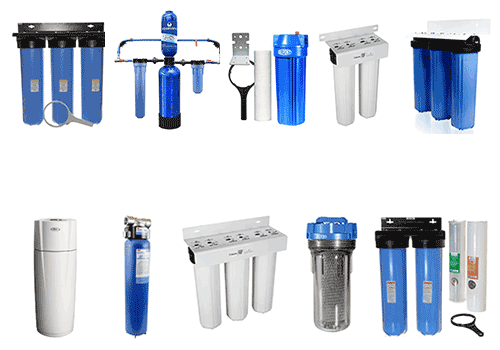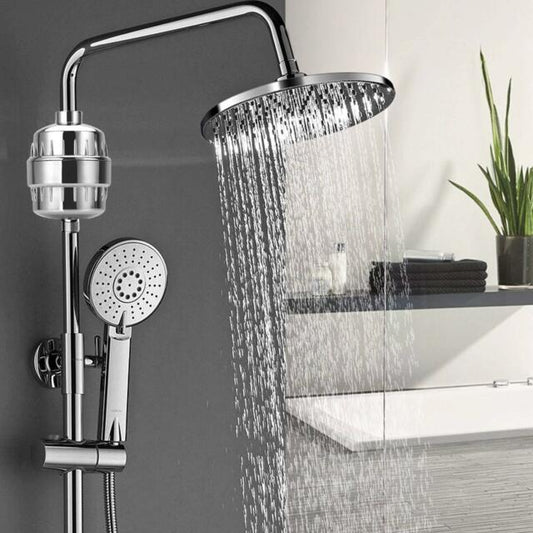In this article, we’re going to look at a few different types of water filters: distillation, reverse osmosis, activated carbon, ultraviolet, and ion exchange.
We’ll explain to you the differences in each, relaying the scientific literature in a way that’s easy to understand, and advise you on which type of water filter is best for your particular situation.
What’s the difference between water softening and water filtration?
There’s no strict definition separating water softeners and water filters. All water softeners are technically water filters, but not all water filters are water softeners.
Hard water is water that contains vast amounts of magnesium and calcium. Water softeners “soften” hard water by removing magnesium and calcium specifically -- not necessarily focusing on other contaminants that might be present in your drinking water.
Water filters, on the other hand, work to remove everything else, from dangerous metals like arsenic and copper to other compounds that you shouldn’t be drinking (like sand, hormones, and pesticides).
In this article, we’ll look at five different types of water filters: distillation, reverse osmosis, activated carbon, ultraviolet, and ion exchange.
Distillation
You’ve undoubtedly seen distilled water at the grocery store at a much higher price than the equivalent amount of water from your tap, or even other bottled water that isn’t labeled “distilled.”
Distilled water is boiled into steam and then collected in a separate container, leaving the contaminants behind. Naturally, since boiling water requires a lot of energy, only about 15% of bottled water companies use this process.
According to the University of Nebraska, distillation is highly effective at removing a number of contaminants from water, including magnesium and calcium. That means, of course, that water distillers function as both water softeners and water filters.
However, every water treatment system has setbacks: “Certain pesticides, volatile solvents, and volatile organic compounds (VOCs), such as benzene and toluene, with boiling points close to or below that of water will vaporize along with the water as it is boiled in the distiller.”
Reverse Osmosis
Reverse osmosis occurs when water is pushed through a semipermeable membrane in order to filter out contaminants. Wastewater containing the contaminants is left on one side of the membrane, and fresh water makes it through to the other side.
Referencing the same article as above, about 45% of water bottle companies use this process to filter water since it’s significantly less expensive than water distillation.
Reverse osmosis removes just about every contaminant from water, but that also has its drawbacks. According to Water and Wastes Digest, reverse osmosis systems can waste up to 20 gallons of water during the purification process.
Activated Carbon
Activated carbon filters use chemical adsorption in order to remove impurities from drinking water. Adsorption is similar to absorption, except the material attaches itself solely to the surface area of another material, instead of being intertwined in its matrix. Absorption is like a sponge soaking up water; adsorption is like a packet of silica gel inside of a pair of new shoes or a bag beef jerky: it “soaks up” small amounts of water, but only on the surface of the packet.
Activated carbon is especially good at attracting organic contaminants, including VOCs like acetone and formaldehyde, among others, but it doesn’t remove bacteria, nitrates, or dissolved minerals. That’s why it’s important to look for an activated carbon filter that comes equipped with a pre-filter, like FilterSmart systems.
Ultraviolet
Ultraviolet light not only causes your skin to burn, it also kills microorganisms. Ultraviolet has a wavelength smaller than visible light; as long as the light is intense enough, it will kill microorganisms by directly targeting their DNA.
Naturally, then, ultraviolet water filters are extremely effective at killing any pathogens or bacteria that might be in your drinking water.
However, according to the University of Hawaii, its effectiveness is variable depending on certain water characteristics. If the water is cloudy, for example, that can affect how much ultraviolet light reaches those pathogens.
Also, naturally, ultraviolet water filters don’t remove any inorganic or metallic compounds. Sand, silt, and sediment -- the exact contaminants that could possibly make water cloudy -- won’t be removed by ultraviolet filtration.
Ion Exchange
Finally, ion exchange filters work by removing magnesium and calcium from hard water, thereby “softening” it. They don’t necessarily target any other pathogens or contaminants (especially ones with ions that have a negative charge).
As such, ion exchange water filters are really only water softeners.
Conclusion: Different Types of Water Filters
There are a few different types of water filters on the market: distillation, reverse osmosis, activated carbon, ultraviolet, and ion exchange.
For most consumer uses, the three most popular filters are reverse osmosis, activated carbon, and ultraviolet. Distillation can be very expensive, and ultraviolet is ineffective when it comes to removing inorganic compounds.
Questions? Concerns? Feel free to get in touch:
Call us: 866.455.9989
Email us: sales@filtersmart.com






